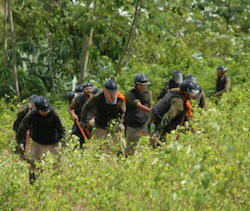Anti-drug authorities in Peru eradicated a record amount of coca in 2015, but this achievement is unlikely to have a major impact on the regional drug trade.
Peru’s National Commission for Development and Life without Drugs, known by its Spanish acronym Devida, announced this week that the government had surpassed its goal of eradicating 35,000 hectares of coca crops by the end of 2015. According to Devida president Alberto Otarola Peñaranda, this amount of eradicated coca is “unprecedented in the country’s history.”
Eradication rates in Peru have been steadily increasing, from around 10,000 hectares per year earlier in the decade to nearly 30,000 hectares last year, local media reported. Devida cited statistics showing more than 109,000 hectares have been destroyed since 2011, with 60 percent of that total having been eradicated in the past two years.
At a ceremony celebrating these efforts, Otarola also highlighted the implementation of alternative crop substitution and rural development programs. According to a press release, Devida invested several million dollars on such projects in the country’s main coca-growing regions this year.
US Ambassador Brian Nichols also attended the event with Otarola and congratulated the Peruvian government on its anti-narcotics work, which has received tens of millions of dollars of US assistance in recent years.
InSight Crime Analysis
Despite rising rates of coca eradication in Peru, the impact of these efforts is likely to be offset by increasing cultivation of the crop in Colombia. In 2013, the United Nations estimated that Peru had surpassed Colombia as the world’s number one cocaine producer, but recent assessments by the US government indicate that Colombia has regained the top position.
SEE ALSO: Coverage of Coca
During extensive field research over the past several months, InSight Crime has detected explosive growth in coca production in various parts of Colombia, including regions where coca cultivation has not traditionally been observed. This increase is likely encouraged in part by rebel group the Revolutionary Armed Forces of Colombia (FARC), which is believed to be using coca production as a bargaining chip during peace negotiations with the government.
Although anti-narcotics agencies are eager to trumpet the successes of drug interdiction and eradication programs, alternative approaches to controlling the illegal drug trade have also shown promise. The most oft-cited example is Bolivia, which has achieved a dramatic reduction in illegal coca cultivation in recent years through its community-based coca control system, popularly known as “coca yes, cocaine no.”
Nevertheless, the Bolivian government continues to carry out significant eradication operations; the most recent official statistics show the country has destroyed more than 11,000 hectares of coca this year.

